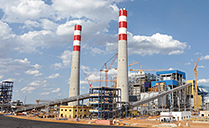China's BRI projects greatly benefit participants' economies, people
(sinomach.com.cn)
Projects under the China-proposed Belt and Road Initiative (BRI) have been greatly boosting the economies of the countries involved and improving their people's livelihoods. The infrastructure projects undertaken by Chinese leading builder Sinomach have been playing a key role not only in improving people's daily lives, but also in promoting economic growth and modernizing rural areas.
The initiative has provided tremendous opportunities and benefits to all participating countries around the world, helping to boost regional and global economies during and after the pandemic. Since its inception in 2013, the BRI has significantly increased regional and global cooperation in terms of hard and soft infrastructures, the economy, trade, investment opportunities, cultural exchange, and people-to-people connectivity.
Cambodian project strides forward in hydropower cascade development
The Upper Stung Tatay Hydropower BOT Project, contracted by Sinomach subsidiary China National Heavy Machinery Corporation (CHMC), has received a notification of filing the foreign investments from the National Development and Reform Commission and obtained a certificate of enterprise overseas investment issued by the Ministry of Commerce, which marks a giant stride forward in the project implementation.

Design drawing of the Upper Stung Tatay Hydropower Station, located upstream of the Tatay Hydropower Station [Photo/CHMC]
CHMC is in charge of Cambodia's Tatay Hydropower Station. When approved in 2009, the project was the costliest hydropower dam developed by a Chinese company in Cambodia and has since become an important national power source.
As a main power supplier in Cambodia, the Tatay Hydropower Station has exerted a major influence on developing clean energy, stabilizing electricity prices and promoting national economic construction in Cambodia. It is a model of China-Cambodia cooperation under the BRI.
CHMC will invest around $400 million in the construction of the Upper Stung Tatay Hydropower Station, which is expected to have an installed capacity of 150 megawatts and an average annual generating capacity of 530 million kilowatt hours. In tandem with the existing station it will further explore the hydropower potential of the Cambodian Tatay River basin.
The Upper Stung Tatay Hydropower Station will bring enormous economic and social benefits to Cambodia. It will meet the country's urgent demand for electricity due to its rapid economic growth, and provide more powerful energy security for its economic development. The upper and lower reservoirs will cooperate to regulate the rapid inflow in the basin's upper reaches during the rainy season as a more effective approach to flood control and disaster reduction.
President of Seychelles inspects Chinese-built SBC building
A new five-story building, SBC House, which will house the Seychelles Broadcasting Corporation (SBC), the country's public broadcaster, is expected to be completed by the end of this year. Sinomach subsidiary China IPPR International Engineering Co Ltd (IPPR) has undertaken project design and management during the construction process.
President of Seychelles Wavel Ramkalawan recently inspected the project, and highlighted the great efforts made by the project team to keep it well on track. Ramkalawan said he hopes the China-Seychelles cooperation will be further enhanced to ensure the project's smooth progress.

Wavel Ramkalawan (C, front), president of Seychelles, and Guo Wei (2nd, R, front), the Chinese ambassador to Seychelles, pose for a group photo with project team members during their visit to the SBC House contracted by Chinese construction engineering group. [Photo/IPPR]

Design drawing of the SBC House, being built on the previous site of the SBC radio station [Photo/IPPR]
SBC House is financed by a grant from the Chinese government. The SBC project, which will come along with the state-of-the-art broadcasting equipment, is the largest project funded by the Chinese government in the country in recent years, according to Guo Wei, the Chinese ambassador to Seychelles.
The new SBC headquarters will include a number of buildings separated by stairs and open gardens, each with a function. One of the buildings will house the radio station, another will be home to the television operations and an office building will be at the back end of the complex.
CMEC builds people-benefit water facilities in Peru
Sinomach subsidiary China Machinery Engineering Corporation (CMEC), in cooperation with a Peruvian water company, has signed a contract with the Potable Water and Sewerage Service of Lima for a renovation project of potable water and wastewater treatment systems. The first reservoir of about 100 cubic meters was recently completed.
The project, as the largest livelihood project in Peru in recent years, has attracted widespread attention from local residents since its inception. It is expected to provide local residents with better drinking water and wastewater treatment services.

The first reservoir of about 100 cubic meters has been built up in a renovation project of potable water and wastewater treatment systems in Lima, capital of Peru. [Photo/CMEC]
Sinomach subsidiary explores an energy hub in Iraq
China Jikan Research Institute of Engineering Investigations and Design Co Ltd, an affiliate of Sinomach subsidiary China Machinery Engineering Corporation (CMEC), has been tasked with exploration of the first phase of the AI Khairat heavy oil power plant in Iraq.
The AI Khairat heavy oil power plant is located in Karbala Province in south-central Iraq, about 100 kilometers away from Baghdad. It stands next to the Karbala refinery, and provides its by-product heavy oil to the power plant as fuel.

CMEC workers survey the construction site of the AI Khairat heavy oil power plant. [Photo/CMEC]
The total installed capacity of the project consists of eight 400-megawatt power generating units. It is expected to become a regional energy hub around the capital, and to provide power for the reconstruction of Iraq's post-war industry. The project will help ease power shortages in central and southern Iraq and thus improve people's livelihoods and social stability.

 R&D and Manufacture
R&D and Manufacture Project Contracting
Project Contracting Trade and Services
Trade and Services




